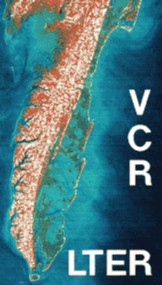 Vegetation dynamics on the Hog Island Chronosequence |

Frank P. Day and Donald R. Young
Dept. of Biological Sciences, Dept. of Biology
|
 Vegetation dynamics on the Hog Island Chronosequence |

Frank P. Day and Donald R. Young
Dept. of Biological Sciences, Dept. of Biology
|
VEGETATION DYNAMICS ON THE HOG ISLAND CHRONOSEQUENCE
Frank P. Day, Old Dominion University and Donald R. Young, Virginia Commonwealth University
Permanent plots and both short-term and long-term experiments along the Hog Island chronosequence are quantifying spatial and temporal vegetation dynamics, as well as the underlying mechanisms. These studies are especially important in defining successional trends and associated mechanisms, both biotic and abiotic. In addition, they provide a thorough comparison of swale and dune communities, as well as woody versus grass dominated communities. This past year saw the continuation of several studies, and the initiation of several new experimental projects.
The long-term nitrogen fertilized plots were fertilized in July 1995 and all control and fertilized plots were inventoried. Plant density and cover were quantified by species. We now have four years of data from these permanent plots, and responses in community composition to fertilization are becoming apparent in addition to the previously recognized increases in production. In general, Ammophila breviligulata appears to be increasing in importance in fertilized areas of the mid-island dunes; the inverse is apparent for Spartina patens. This year we plan to initiate a litter decomposition study in the long-term fertilization plots.
Measurements of root growth also continued within the experimental plots. Observations were recorded in the minirhizotron tubes in June and September. We now have four growing seasons of data from these tubes, and to our knowledge this is one of the longer records of root observations in minirhizotrons. The longer term data suggest that there are different classes of roots based on longevity and this probably relates to functional differences. A new project involving additional tubes and experimental manipulations will address questions related to differential responses of root systems in different nutrient regimes to additional nutrient inputs.
The ground water wells continue to be maintained monthly. We now have five years of continuous data on ground water levels across the chronosequence. We plan to work with a hydrologist on synthesis of these data. We are accumulating several substantial long-term data sets that are yielding valuable results.
To elucidate factors controlling the small-scale distribution and successional dynamics of woody species, four sets of permanent plots (5 x 10 m) were established during the summer of 1995. The four sites represent shrub colonization, thicket expansion, stable thicket and thicket senescence. For each plot (n=3 per site) the location coordinates, species and basal diameter were recorded for each stem. Shrub height was also recorded at the colonizing site. These plots will be measured every three years to determine recruitment and mortality patterns. In addition, all plots will be visited on an annual basis to determine spatial and annual variations in new shoot growth, which reflects production. These data have been collected each October since 1990.
Experimental plots at the shrub colonization site are designed to determine potential interactions (facilitation vs. inhibition) between the swale grasses and the shrub seedlings. Understanding these interactions will elucidate mechanisms controlling the successional development of thickets. Seedling growth, survival, herbivory, photosynthetic performance, and water relations are being monitored. Monitoring was initiated in May of 1995 and will continue for one or two more growing seasons.
An array of experimental plots was also established in 1995 to identify the degree of allelopathy that may facilitate thicket expansion in the grass swales. Five plots (1 x 1 m) each of four different treatment combinations of Myrica and straw litter at two depths were located on a dune ridge. The experiment is repeated in a grass swale. The plots will be maintained for at least two years. At the end of each growing season, above ground production and species composition will be determined and compared with control plots.